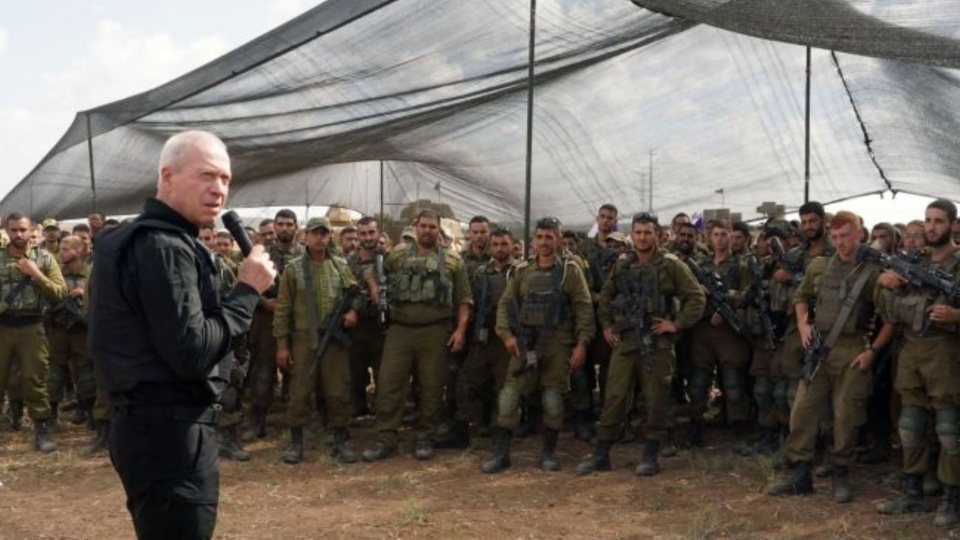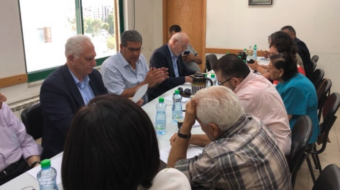
KHAN YOUNIS, Gaza Strip (AP)—Israel pounded the Gaza Strip with airstrikes on Thursday, including in the south where Palestinians were told they would be safe, and the country’s defense minister told ground troops to “be ready” to invade, though he didn’t say when.
In a fiery speech to Israeli infantry soldiers on the Gaza border, Defense Minister Yoav Gallant urged the forces to “get organized, be ready” for an order to move in. Israel has massed tens of thousands of troops along the border.
“Whoever sees Gaza from afar now, will see it from the inside … I promise you,” he said. “It might take a week, a month, two months until we destroy them,” he added, referring to Hamas.
In an interview with ABC News Thursday afternoon, Economy Minister Nir Barakat said that hostages and civilian casualties will be secondary to destroying Hamas, “even if it takes a year.”
Israel’s consent for Egypt to let in food, water, and medicine provided the first possibility for an opening for the sealed territory. Many of Gaza’s residents are down to one meal a day and drinking dirty water.
Israel did not list fuel as a permitted item, but a senior Egyptian security official said Egypt was negotiating for the entry of fuel for hospitals. The official spoke on condition of anonymity because he was not authorized to talk to the press.
More than 200 trucks and some 3,000 tons of aid are positioned at or near Rafah, according to Khalid Zayed, the head of the Red Crescent for North Sinai.
Under an arrangement reached between the United Nations, Israel, and Egypt, U.N. observers will inspect the trucks carrying aid before entering Gaza. A U.N. flag will be raised on both sides of the crossing as, hopefully, protection against Israeli airstrikes.
It is not immediately clear how much cargo the crossing can handle. Waleed Abu Omar, spokesman for the Palestinian side, said work has not started to repair the road between the two gates damaged by Israeli strikes.
Israel had previously said it would let nothing into Gaza until Hamas freed the hostages taken in the initial attack of Oct. 7. Relatives of some of the captives reacted with fury to the aid announcement. “The Israeli government pampers the murderers and kidnappers,” the Hostage and Missing Families Forum said in a statement.
With the Egypt-Gaza border crossing in Rafah still closed, however, the already dire conditions at Gaza’s second-largest hospital have deteriorated further, said Dr. Mohammed Qandeel of Nasser Hospital in the southern town of Khan Younis. Power has been shut off in most departments to save it for intensive care and other vital functions, and staff members are using mobile phones for light.
At least 80 wounded civilians and 12 dead flooded into the hospital Thursday morning after witnesses said a strike hit a residential building in the town. Doctors had no choice but to leave two of the incoming to die because there were no ventilators left, Qandeel said.
“We can’t save more lives if this keeps happening, meaning more children…more women will die,” he said.
The Gaza Health Ministry pleaded with gas stations to give whatever fuel they had left to hospitals. The U.N. agency for Palestinian refugees gave some of its last remaining fuel supplies to hospitals, spokesperson Juliette Touma said.
The agency’s donation to Gaza City’s Shifa Hospital, the territory’s largest, would “keep us going for another few hours,” hospital director Mohammed Abu Selmia said.
The Gaza Health Ministry said 3,785 people have been killed in Gaza since the war began, the majority of them women, children, and older adults. Nearly 12,500 others have been injured, and another 1,300 people were believed buried under the rubble, health authorities said.
More than 1,400 people in Israel have been killed, most in the initial Hamas attack of Oct. 7. Roughly 200 others are thought to still be held captive inside Gaza.
More than 1 million Palestinians, roughly half of Gaza’s population, have fled their homes in Gaza City and other places in the northern part of the territory since Israel told them to evacuate. Most have crowded into U.N.-run schools-turned-shelters or the homes of relatives.
The Israeli military has relentlessly attacked Gaza in retaliation for the Hamas attack almost two weeks ago. Even after Israel told Palestinians to evacuate the north of Gaza and flee south, strikes extended across the territory, heightening fears among the territory’s 2.3 million people that nowhere is safe.
Palestinian militants fired rockets into Israel on Thursday from Gaza and Lebanon, and battles erupted in the Israeli-occupied West Bank.
Now, all eyes are on the Israeli troops massing on the border, and Gazans worry about what awaits them next.
This article from AP has been updated with further developments since the time of its original publication.
We hope you appreciated this article. At People’s World, we believe news and information should be free and accessible to all, but we need your help. Our journalism is free of corporate influence and paywalls because we are totally reader-supported. Only you, our readers and supporters, make this possible. If you enjoy reading People’s World and the stories we bring you, please support our work by donating or becoming a monthly sustainer today. Thank you!














Comments